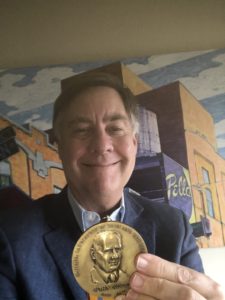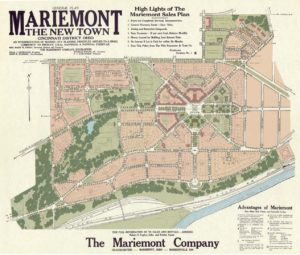See Dr. Bruce Stephenson as the keynote speaker at the 28th Annual Fall Forum on Friday, October 13th at Noon in the Hilton Netherland Plaza.

Q. Why Planning?
A. Stephenson grew up off the eastern Florida coast on Merritt Island near the floodplain of St. Johns River. When the wetland soils dried out due to droughts, the peat-like material caught fire eight feet below the surface. This natural disaster became the topic of Stephenson’s high school science project which led him to discover that many environmental problems, such as the one he was witnessing in his own backyard, were exacerbated by bad urban planning. Later he would grow up to be one of the nation’s leading planners, taking vast inspiration from early planner John Nolen. Nolen is, of course, the Cincinnati icon who created the plan for Mary Emery’s Village of Mariemont in 1923, among many others.
“As I started drafting plans I realized, John Nolen has already made these plans… 100 years ago!” -Bruce Stephenson

Stephenson receiving the John Nolen Medal in 2020⇒
Q. What is New Urbanism?
A. It all started in 1993 in Seaside, Florida with a town so picturesque it was the backdrop for The Truman Show starring Jim Carrey. What was once seen as merely 80 acres of sand and scrub was turned into the world’s first New Urbanist town. The neo-classical plan put homes closer together to protect the natural resources. The plan proved itself in 1995 when a Category 3 hurricane left no damage in its wake. This is thanks to the Urban Plan which built behind the dune system, elevated all buildings 1-2 feet off ground, kept all native landscaping and included building codes requiring tin roofs. Similarly to Mariemont in Ohio, Seaside designed by Andrés Duany and Elizabeth Plater-Zyberk is very walkable and community focused.
“New Urbanism is a planning and development approach based on the principles of how cities and towns had been built for the last several centuries: walkable blocks and streets, housing and shopping in close proximity, and accessible public spaces. In other words: New Urbanism focuses on human-scaled urban design.” –Congress for the New Urbanism
Q. How long will it take?
A. New Urbanism is a long-term investment. Plans typically have a 25 year time frame, yet are often priceless. For example, Central Park took 25 years to come to fruition and there is no argument that it was well worth the wait. Planners set out to resolve economic tears in the social fabric spurred by diversity to create a space designed to bring all people together regardless of their backgrounds.

Another example from Bruce’s work directly can be seen in the Park plans for Portland and Seattle which specifically included saving the creeks and wetlands rather than developing them. Thus, preventing the city from flooding during heavy rains. The important role these plans play will not only impact our future, but primarily our children’s future.
⇐ Stephenson in the Portland’s Pearl Magazine in 2016
Q. Looking Forward – Is there Hope?
A. New Urbanist principles are sustainability and racial equity rooted in pedestrian-oriented design. Stephenson points out some good news among these two monumental challenges. There is a huge opportunity to make money!
Imagine living in a place where you could walk to get all your basic needs. Because at least one third of the population is saying “Sign me up,” this makes the most valuable real estate in the country urban places where people can walk to get their groceries.

Q. What is your favorite planned community?
A. In his living room, Stephenson has an image of the original town square in Mariemont which includes a fountain, church, residential and commercial properties all built very thoughtfully 100 years ago.
“It’s the most beautiful work of civic art in the country.” -Bruce Stephenson
Beyond the US, Pienza is at the top of Stephenson’s list. First mentioned in documents dating back to the 9th century, Pienza, Italy was designed as the “touchstone of Renaissance urbanism” and built to embody the humanist vision of the “ideal town”. Pienza was the birthplace of Aeneas Silvius Piccolomini, who would become Pope Pius II. After he became Pope, Piccolomini had the entire village rebuilt to serve as a retreat from Rome. In 1996, UNESCO declared the town a World Heritage Site, and in 2004 the entire valley, the Val d’Orcia, was included on the list of UNESCO’s World Cultural Landscapes.

Old Town Square, Mariemont ⇒
About Dr. Bruce Stephenson
Bruce Stephenson is dedicated to the art of city planning. A Rollins professor and consultant, he is a recipient of the John Nolen Medal, the 1000 Friends of Florida Better Community Award, and the Graham Frey Civic Award, and his biography, John Nolen, Landscape Architect and City Planner, won the JB Jackson book award. Serving on the Orlando Sustainability Task Force and the Pearl District (Portland) Planning & Transportation Committee inspired his most recent book, Portland’s Good Life: Sustainability and Hope in an American City. Currently, Stephenson is working on a new book, The Clansman and the City Plan: Thomas Dixon, John Nolen and the Birth of a New Nation.
Learn more about Bruce Stephenson, his work and publications at Living New Urbanism.
